For every navy, long before the advent of radar and other
high-tech sensory devices, the most important tool for tracking an
enemy's movements was the human eye. Initially that eye was placed high
atop a ship's mast in the crow's nest. With the advent of aircraft,
heavier-than-air and otherwise, military leaders immediately saw the
means of putting those eyes higher and farther ahead of their forces.
This is especially important in the vast stretches of the Pacific Ocean,
where an enemy fleet can easily move long distances without detection
otherwise. Both the United States and Japan recognized this
vulnerability and designed series of very long-range seaplanes to form a
visual picket of their Pacific holdings, each making long, sweeping arcs
over the shimmering expanses with several pairs of eyes
(maintaining varying degrees of attention) looking to see what was out
there.
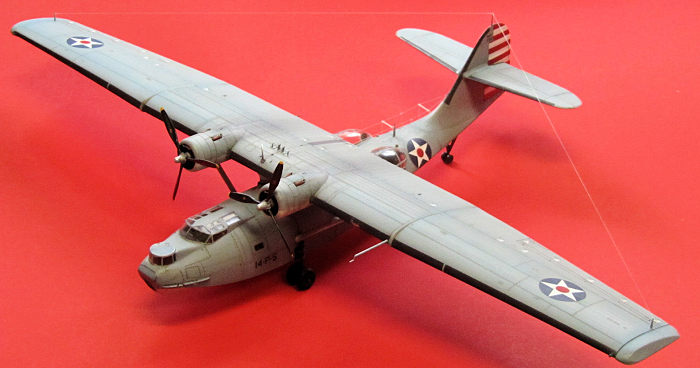 The PBY is easily the most famous of these, but--strange to
think--it was very nearly only a minor player in World War II. Having
been in service in developed form since 1936, it was well liked by both
aircrew and senior staff. However, larger and significantly more capable
replacements, the PBM Mariner, Boeing Sea Ranger, and Consolidated's own
Coronado were being tested and entering service in the years leading up
to the war, and the PBY was scheduled to leave service in 1941.
The PBY is easily the most famous of these, but--strange to
think--it was very nearly only a minor player in World War II. Having
been in service in developed form since 1936, it was well liked by both
aircrew and senior staff. However, larger and significantly more capable
replacements, the PBM Mariner, Boeing Sea Ranger, and Consolidated's own
Coronado were being tested and entering service in the years leading up
to the war, and the PBY was scheduled to leave service in 1941.
It was the Royal Navy who both changed this, continuing
production by ordering 30 in the desperate buildup following the Munich
Crisis, and gave the PBY its best-known name, "Catalina". This order
saved the design from termination, and set the stage for the aircraft to
play the major and pivotal role that it did. Giving it a name made it
immortal. Therefore available and present at the first shot of World War
II all over the world in large numbers, easy to service, and extremely
dependable, the PBY Catalina would be built greater numbers than all
other flying boat types combined simply by dint that it was present in
quantity from the beginning and did its job well. While the Martin
Mariner did slowly assume the Catalina's combat roles after 1942 it
never supplanted them completely. The Sea Ranger was found redundant and
rejected for a production contract and the Coronado--a little
disappointing and relegated mostly to transport.
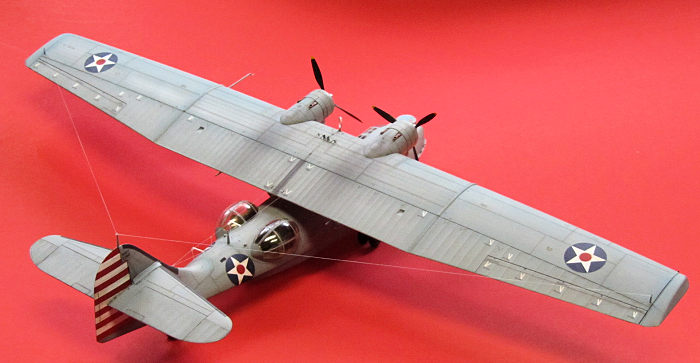 A handful had been in civilian service all along. Typical for
such an adaptable, reliable, and very available aircraft, and even more
so as seaplane/amphibian, it right away found employment in all sorts of
roles in the postwar world and is one of a few wartime types still
earning paid service in 2020.
A handful had been in civilian service all along. Typical for
such an adaptable, reliable, and very available aircraft, and even more
so as seaplane/amphibian, it right away found employment in all sorts of
roles in the postwar world and is one of a few wartime types still
earning paid service in 2020.
Directional stability was always a problem, and the
area/shape of the vertical tail kept being changed and increased
throughout production and in various postwar modifications. The pure
seaplane -5 was the best-performing of the lot, being unencumbered with
the 3000 lbs. of landing gear dead weight of the amphibian versions.
Wartime need meant that some of the amphibian versions even had their
landing gear removed in the field to achieve this performance. Though
this lighter variant accounted for about a third of total production,
its reduced utility meant that of the eighty or so Catalinas that
survive today it only accounts for three or four airframes.
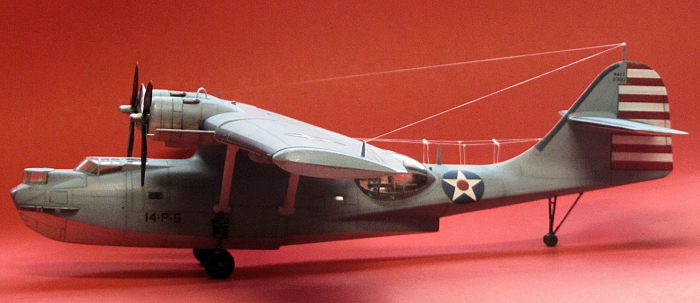 As the most iconic seaplane of all time, there have been
Catalina kits as long as there've been plastic kits as we know them.
Aurora provided the earliest one in very approximate 1/72 ("5/32 scale")
in 1957. Airfix and Revell both gave us good ones in 1/72 in the
sixties, both relegated to the back seat when Academy's came out about
1994. Revell brought out a -5A in 1/48 shortly afterward, nicely
detailed but cursed with a vertical fin too fat.
As the most iconic seaplane of all time, there have been
Catalina kits as long as there've been plastic kits as we know them.
Aurora provided the earliest one in very approximate 1/72 ("5/32 scale")
in 1957. Airfix and Revell both gave us good ones in 1/72 in the
sixties, both relegated to the back seat when Academy's came out about
1994. Revell brought out a -5A in 1/48 shortly afterward, nicely
detailed but cursed with a vertical fin too fat.
This offering is typical of Academy's US WWII multi-engined
kits which came out at the time. Nice, crisp, and comprehensive engraved
detail, some slightly clunky engines and props, very good overall shape
and outlines, and easy construction. Admirably, and per the rest of this
series, all the major production versions of this classic aircraft from
the -2 to the -5A are provided for in various boxings. There have been
various resin and vacuform sets to convert the -5A into the tall-tail
-6A and PBN Nomad versions.
Typical for Academy of the early '90s, tires are provided in
black rubber. Live with it, bucko.
A quarter century on, this is still really a very good kit
and there are no actual problems in the build. As in any model there are
a few inaccuracies, but happily as it turns out the more obvious they
are, the easier they are to fix. In descending order (as in 'descent
into hell'):
1) The pair of wheels on each beaching gear leg sit much too far
apart. The engineering of the axles doesn't make shortening of them an
option, so simply slice off the shallow 'cone' detail on the inside
faces of the
 wheels (part A9) flush with the surrounding rims and
they'll slide right in where they should be. Five minutes' work, maybe.
wheels (part A9) flush with the surrounding rims and
they'll slide right in where they should be. Five minutes' work, maybe.
2) The hinge line of the elevator is one panel line too far aft.
The real PBY featured massive barn-door elevators extending well forward
of the half-chord line of the stabs. Simply fill the existing hinge line
and sand, then deepen the next one forward if so desired with more
scribing and shaping to represent the new hinge line. You can also
instead go a lazier route and simply emphasize the correct lines with a
dark wash during finishing. Again, not a big challenge.
3) The engine cowls and nacelles are slightly too big. Probably
not worth correcting for most modelers, I didn't discover this one until
it was too late to do anything about it anyway. Quickboost offers a
corrected cowl, taking care of the first part of the problem, but not
the nacelles. I'm not really sure about what you'd do to fix that part,
short of laboriously slicing off the nacelle bulges, dividing them into
quarters, removing about 1/16" off the width of each, gluing them back
in place carefully matching the diameter of the resin cowls, then
sanding and rescribing. In the end I didn't think it was worth the
hassle since the error really isn't noticeable. I did use the Quickboost
engines and props since the kit parts are a bit clunky, though the
resin's blade shape still isn't quite pointy enough. If you're anything
but among the most uptight of modelers I'd ignore this group of issues
completely.
There are also the various omitted little details and
problems resulting from Academy's kit engineers doing their best to deal
with the PBY's complex fuselage contours. A scribed skylight panel on
the right side of the fuselage aft of the gunners' blisters needs to be
opened up and represented with clear plastic. The gunners' sem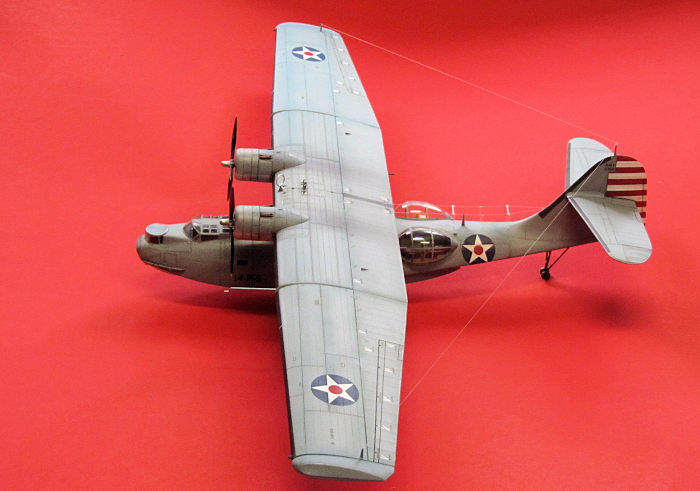 icircular
platforms need to be shortened and lowered to a position on the bottom
of the hull, then former-and-stringer detail added in their place. I
actually ended up spending quite a while detailing this compartment
since those big blisters let in a lot of light and the space is pretty
visible, even in 1/72. This included a toilet fashioned from a 1/15
Bandai Panzer IV smoke-discharger.
icircular
platforms need to be shortened and lowered to a position on the bottom
of the hull, then former-and-stringer detail added in their place. I
actually ended up spending quite a while detailing this compartment
since those big blisters let in a lot of light and the space is pretty
visible, even in 1/72. This included a toilet fashioned from a 1/15
Bandai Panzer IV smoke-discharger.
Finally, a little more detail was added to the less-visible
spaces of the cockpit and forward turret. Holes and cleats were carved
and shaped from the spray guard/crew footholds either side of the bow,
and I replaced Academy's simplified fuel vents on top of the wing with
finer ones of brass rod. All canopies were replaced with those of the
vacuform Squadron/Falcon set. Common to all Catalina kits, the gunners'
blisters are depicted as smooth teardrops omitting the recessed panel
that rotated inward to allow crew access and expose the gun. I didn't
pick a fight with that one.
General assembly followed, no problems. The
wiser modeler may want to leave off the wing and struts until after
basic colors are painted. This less-than-wise modeller didn't, and good
times were had getting paint/weathering into all those awkward little
nooks and crannies around the root and pylon.
The kit provides an attractive option from the prewar Yellow
Wing era, but I wanted my -5 to be an early-war workhorse. Wolfpack
decals out of Korea (not to be confused with the also-excellent
American Wolf-Pak decals) provided these markings. After spraying the
basic colors of Intermediate Blue over a very light Gull Gray under a
coat of Future these snuggled right down into the panel and rivet lines
with Micro Set and Sol.
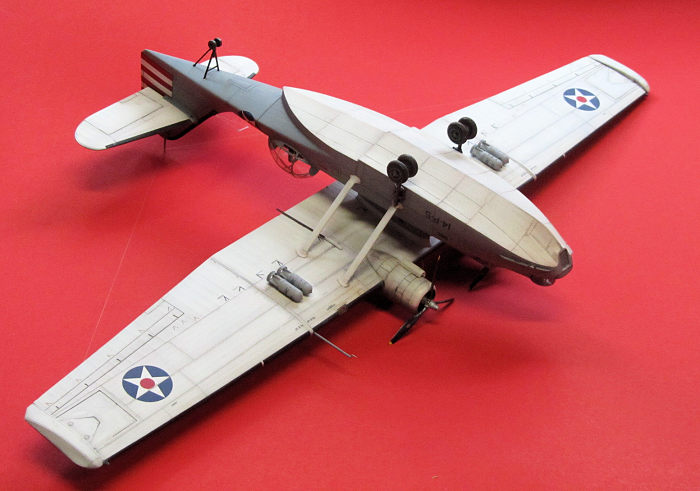 Sidebar note: As of this writing Wolfpack is offering a
special release of the Academy kit with a set of their decals, including
an example with the gigantic full-chord national markings on the wings.
It even includes a complete set of precut canopy masks.
Sidebar note: As of this writing Wolfpack is offering a
special release of the Academy kit with a set of their decals, including
an example with the gigantic full-chord national markings on the wings.
It even includes a complete set of precut canopy masks.
That big plank of a wing presents a lot of uninterrupted
surface area which could turn out really bland in such a drab basic
color, so I went full-tilt boogie and threw every weathering and
highlighting technique I could think of at it, including some
post-shading with heavily thinned Tamiya Clear Blue (X-23). Academy's
crisp engraved detail takes an oil wash really well...be sure to
emphasize it more around the center-section and engines, where the
maintenance crew would be spending most of their time. I might have
overdone it a tad.
Though the kit comes with a quartet of really overscale
500-lb bombs, I armed my Catalina with a two pairs of Attack Squadron Mk
XVII depth charges, currently available from BrenGun. The PBY's complex
spiderweb of various low-frequency antennas running this way and that
was represented in simplified form with EZ Line.
Build it straight form the box or go to town and detail the
stuffing out of it! Nothing to be found here but enjoyment. Still the
best Catalina in any scale.
Dorney, Louis B. US Navy PBY Units of the Pacific War. Osprey
Publishing Ltd. Botley, Oxford UK 2007
Scarborough, WE. PBY Catalina in action. Squadron-signal
Publications, Carrolton, TX 1983
Bowers, Peter. Long Range Patrol Pt. I & II.
Vol 24, No 5 & 6 Airpower Ma.gazine, Granada Hills, CA 1994


 The PBY is easily the most famous of these, but--strange to
think--it was very nearly only a minor player in World War II. Having
been in service in developed form since 1936, it was well liked by both
aircrew and senior staff. However, larger and significantly more capable
replacements, the PBM Mariner, Boeing Sea Ranger, and Consolidated's own
Coronado were being tested and entering service in the years leading up
to the war, and the PBY was scheduled to leave service in 1941.
The PBY is easily the most famous of these, but--strange to
think--it was very nearly only a minor player in World War II. Having
been in service in developed form since 1936, it was well liked by both
aircrew and senior staff. However, larger and significantly more capable
replacements, the PBM Mariner, Boeing Sea Ranger, and Consolidated's own
Coronado were being tested and entering service in the years leading up
to the war, and the PBY was scheduled to leave service in 1941.  A handful had been in civilian service all along. Typical for
such an adaptable, reliable, and very available aircraft, and even more
so as seaplane/amphibian, it right away found employment in all sorts of
roles in the postwar world and is one of a few wartime types still
earning paid service in 2020.
A handful had been in civilian service all along. Typical for
such an adaptable, reliable, and very available aircraft, and even more
so as seaplane/amphibian, it right away found employment in all sorts of
roles in the postwar world and is one of a few wartime types still
earning paid service in 2020. As the most iconic seaplane of all time, there have been
Catalina kits as long as there've been plastic kits as we know them.
Aurora provided the earliest one in very approximate 1/72 ("5/32 scale")
in 1957. Airfix and Revell both gave us good ones in 1/72 in the
sixties, both relegated to the back seat when Academy's came out about
1994. Revell brought out a -5A in 1/48 shortly afterward, nicely
detailed but cursed with a vertical fin too fat.
As the most iconic seaplane of all time, there have been
Catalina kits as long as there've been plastic kits as we know them.
Aurora provided the earliest one in very approximate 1/72 ("5/32 scale")
in 1957. Airfix and Revell both gave us good ones in 1/72 in the
sixties, both relegated to the back seat when Academy's came out about
1994. Revell brought out a -5A in 1/48 shortly afterward, nicely
detailed but cursed with a vertical fin too fat. wheels (part A9) flush with the surrounding rims and
they'll slide right in where they should be. Five minutes' work, maybe.
wheels (part A9) flush with the surrounding rims and
they'll slide right in where they should be. Five minutes' work, maybe. icircular
platforms need to be shortened and lowered to a position on the bottom
of the hull, then former-and-stringer detail added in their place. I
actually ended up spending quite a while detailing this compartment
since those big blisters let in a lot of light and the space is pretty
visible, even in 1/72. This included a toilet fashioned from a 1/15
Bandai Panzer IV smoke-discharger.
icircular
platforms need to be shortened and lowered to a position on the bottom
of the hull, then former-and-stringer detail added in their place. I
actually ended up spending quite a while detailing this compartment
since those big blisters let in a lot of light and the space is pretty
visible, even in 1/72. This included a toilet fashioned from a 1/15
Bandai Panzer IV smoke-discharger.  Sidebar note: As of this writing Wolfpack is offering a
special release of the Academy kit with a set of their decals, including
an example with the gigantic full-chord national markings on the wings.
It even includes a complete set of precut canopy masks.
Sidebar note: As of this writing Wolfpack is offering a
special release of the Academy kit with a set of their decals, including
an example with the gigantic full-chord national markings on the wings.
It even includes a complete set of precut canopy masks.